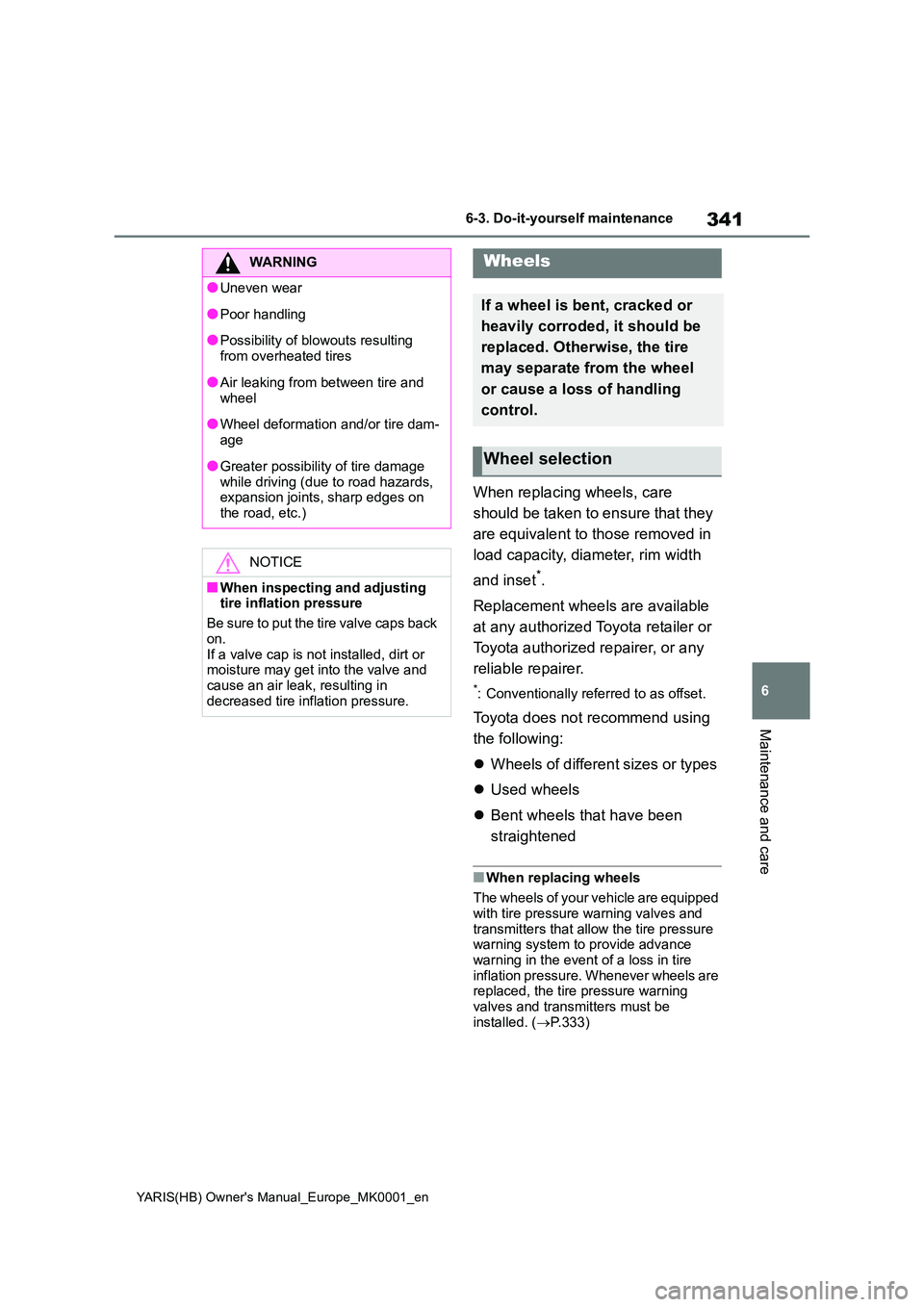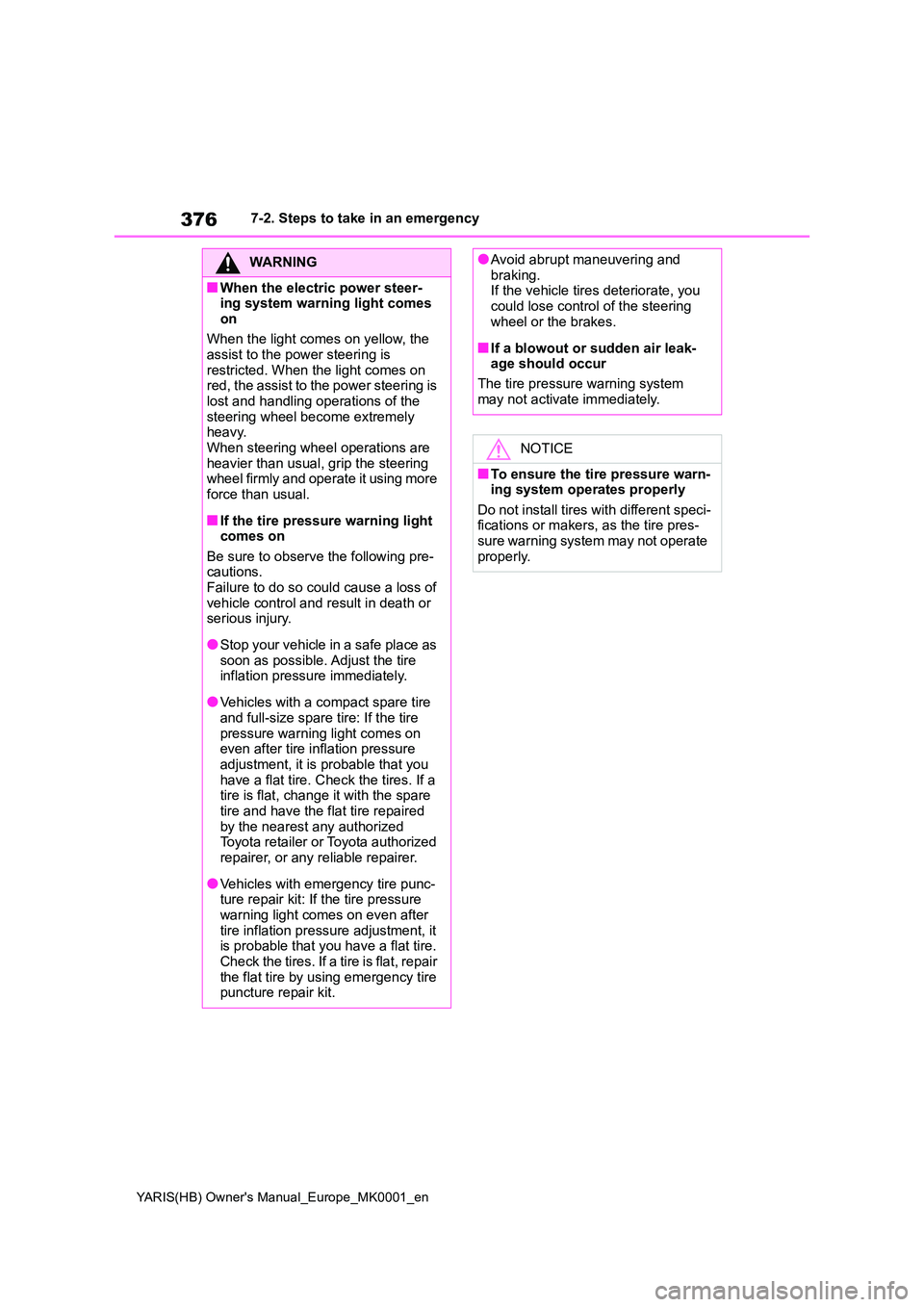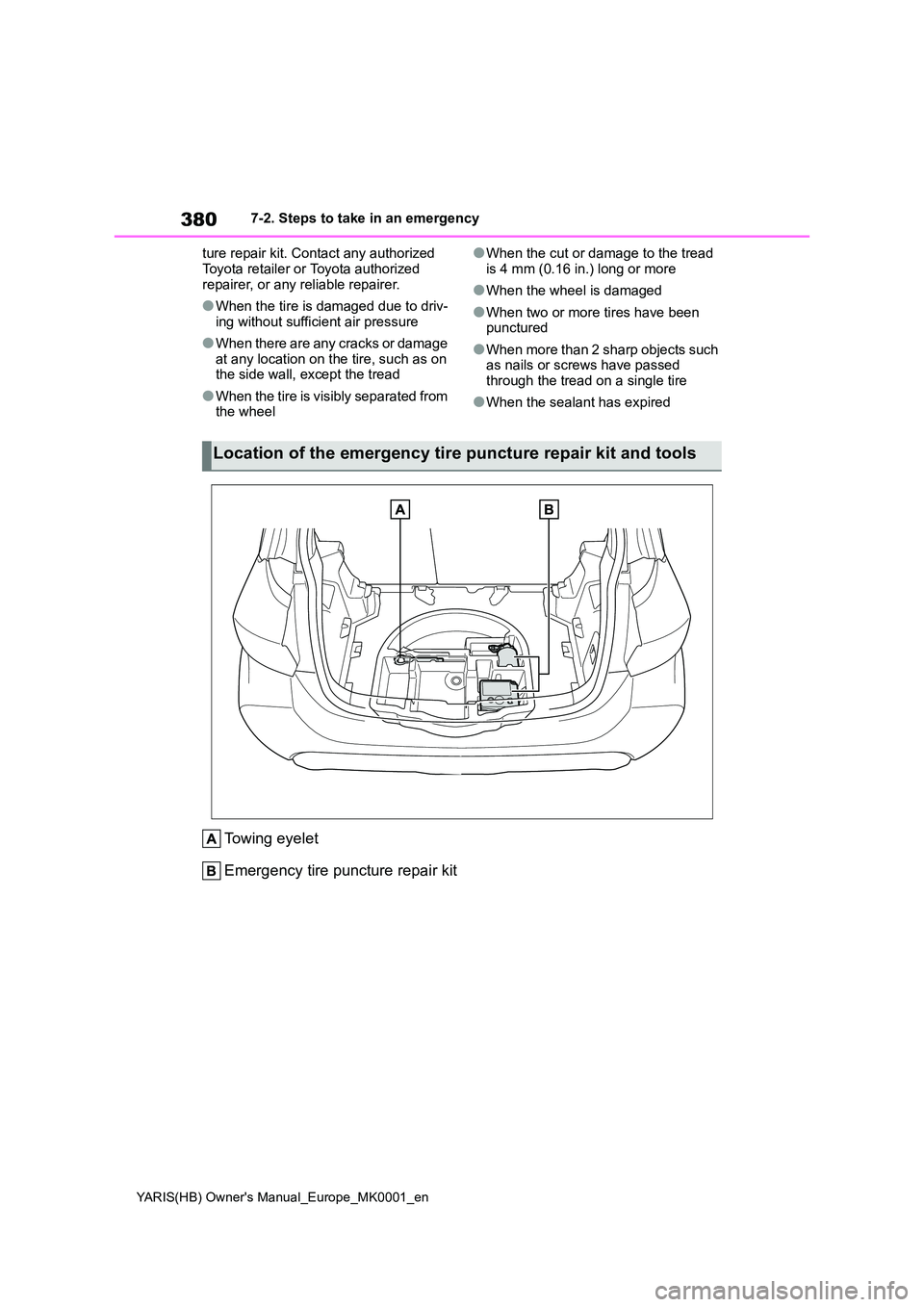2021 TOYOTA YARIS HATCHBACK tire pressure
[x] Cancel search: tire pressurePage 341 of 568

341
6
YARIS(HB) Owner's Manual_Europe_MK0001_en
6-3. Do-it-yourself maintenance
Maintenance and care
When replacing wheels, care
should be taken to ensure that they
are equivalent to those removed in
load capacity, diameter, rim width
and inset*.
Replacement wheels are available
at any authorized Toyota retailer or
Toyota authorized repairer, or any
reliable repairer.
*: Conventionally referred to as offset.
Toyota does not recommend using
the following:
�z Wheels of different sizes or types
�z Used wheels
�z Bent wheels that have been
straightened
■When replacing wheels
The wheels of your vehicle are equipped with tire pressure warning valves and
transmitters that allow the tire pressure warning system to provide advance warning in the event of a loss in tire
inflation pressure. Whenever wheels are replaced, the tire pressure warning valves and transmitters must be
installed. ( →P.333)
WARNING
●Uneven wear
●Poor handling
●Possibility of blowouts resulting
from overheated tires
●Air leaking from between tire and
wheel
●Wheel deformation and/or tire dam-
age
●Greater possibility of tire damage
while driving (due to road hazards, expansion joints, sharp edges on the road, etc.)
NOTICE
■When inspecting and adjusting tire inflation pressure
Be sure to put the tire valve caps back
on. If a valve cap is not installed, dirt or moisture may get into the valve and
cause an air leak, resulting in decreased tire inflation pressure.
Wheels
If a wheel is bent, cracked or
heavily corroded, it should be
replaced. Otherwise, the tire
may separate from the wheel
or cause a loss of handling
control.
Wheel selection
Page 342 of 568

342
YARIS(HB) Owner's Manual_Europe_MK0001_en
6-3. Do-it-yourself maintenance
■When removing the wheel orna-
ment (vehicles with a wheel cap clip)
Remove the wheel ornament using the
wheel cap clip*.*: The wheel cap clip is installed in the
glove box. ( →P.293)
�zUse only Toyota wheel nuts and
wheel nut wrenches designed for
use with your aluminum wheels.
WARNING
■When replacing wheels
●Do not use wheels that are a differ- ent size from those recommended in the Owner’s Manual, as this may
result in a loss of handling control.
●Never use an inner tube in a leak-
ing wheel which is designed for a tubeless tire.Doing so may result in an accident,
causing death or serious injury.
■When installing the wheel nuts
●Be sure to install the wheel nuts with the tapered ends facing inward ( →P.394). Installing the nuts with
the tapered ends facing outward can cause the wheel to break and eventually cause the wheel to come
off while driving, which could lead to an accident resulting in death or serious injury.
●Never use oil or grease on the wheel bolts or wheel nuts.Oil and grease may cause the
wheel nuts to be excessively tight- ened, leading to bolt or disc wheel damage. In addition, the oil or
grease can cause the wheel nuts to loosen and the wheel may fall off, causing an accident and resulting in
death or serious injury. Remove any oil or grease from the wheel bolts or wheel nuts.
■Use of defective wheels prohib-ited
Do not use cracked or deformed wheels. Doing so could cause the tire to leak air during driving, possibly
causing an accident.
NOTICE
■Replacing tire pressure warning valves and transmitters
●Because tire repair or replacement may affect the tire pressure warning valves and transmitters, make sure
to have tires serviced by any autho- rized Toyota retailer or Toyota authorized repairer, or any reliable
repairer. In addition, make sure to purchase your tire pressure warn-ing valves and transmitters at any
authorized Toyota retailer or Toyota authorized repairer, or any reliable repairer.
●Ensure that only genuine Toyota wheels are used on your vehicle.
Tire pressure warning valves and transmitters may not work properly with non-genuine wheels.
Aluminum wheel precau-
tions (if equipped)
Page 372 of 568

372
YARIS(HB) Owner's Manual_Europe_MK0001_en
7-2. Steps to take in an emergency
■Tire pressure warning light
■LTA indicator* (warning buzzer)
*: This light illuminates on the multi-information display.
■Stop & Start cancel indicator (warning buzzer)
Warning lightDetails/Actions
When the light comes on after blinking for approximately 1 minute
(a buzzer does not sounds):
Malfunction in the tire pressure warning system
→ Have the system checked by any authorized Toyota retailer
or Toyota authorized repairer, or any reliable repairer.
When the light comes on (a buzzer sounds):
Low tire inflation pressure from natural causes
→ Adjust the tire inflation pressure to the specified cold tire
inflation pressure level. ( →P.417)
Low tire inflation pressure from flat tire
→ Immediately stop the vehicle in a safe place.
Handling method ( →P.375)
Warning lightDetails/Actions
(Orange)
(if equipped)
Indicates a malfunction in the LTA (Lane Tracing Assist)
→ Follow the instructions displayed on the multi-information
display. ( →P.212)
Warning lightDetails/Actions
(Flashes)
(if equipped)
Indicates a malfunction in the Stop & Start system
→ Have the vehicle inspected by any authorized Toyota
retailer or Toyota authorized repairer, or any reliable
repairer immediately.
Page 375 of 568

375
7
YARIS(HB) Owner's Manual_Europe_MK0001_en
7-2. Steps to take in an emergency
When trouble arises
ble.
■Electric power steering system
warning light (warning buzzer)
When the battery charge becomes insufficient or the voltage temporarily
drops, the electric power steering sys- tem warning light may come on and the warning buzzer may sound.
■When the tire pressure warning
light comes on
Inspect the tires to check if a tire is punctured.
If a tire is punctured: →P.379, 389
If none of the tires are punctured: Turn the engine switch off then turn it to
ON. Check if the tire pressure warning light comes on or blinks.
If the tire pressure warning light blinks
for approximately 1 minute then stays on
There may be a malfunction in the tire
pressure warning system. Have the vehicle inspected by any authorized Toyota retailer or Toyota authorized
repairer, or any reliable repairer immedi- ately.
If the tire pressure warning light
comes on
1 After the temperature of the tires has lowered sufficiently, check the infla-tion pressure of each tire and adjust
them to the specified level.
2 If the warning light does not turn off even after several minutes have elapsed, check that the inflation
pressure of each tire is at the speci- fied level and perform initialization. ( →P.334)
■The tire pressure warning light may
come on due to natural causes
The tire pressure warning light may come on due to natural causes such as
natural air leaks and tire inflation pres- sure changes caused by temperature. In this case, adjusting the tire inflation
pressure will turn off the warning light (after a few minutes).
■When a tire is replaced with a spare
tire
Vehicles with a compact spare tire: The compact spare tire is not equipped with
a tire pressure warning valve and trans- mitter. If a tire goes flat, the tire pressure warning light will not turn off even
though the flat tire has been replaced with the spare tire. Replace the spare tire with the repaired tire and adjust the
tire inflation pressure. The tire pressure warning light will go off after a few min-utes.
Vehicles with a full-size spare tire: The spare tire is also equipped with a tire pressure warning valve and transmitter.
The tire pressure warning light will turn on if the tire inflation pressure of the spare tire is low. If a tire goes flat, the
tire pressure warning light will not turn off even though the flat tire has been replaced with the spare tire. Replace the
spare tire with the repaired tire and adjust the tire inflation pressure. The tire pressure warning light will go off after a
few minutes.
■Conditions that the tire pressure warning system may not function properly
→ P. 3 3 3
WARNING
■If both the ABS and the brake system warning lights remain on
Stop your vehicle in a safe place immediately and contact any autho-rized Toyota retailer or Toyota autho-
rized repairer, or any reliable repairer. The vehicle will become extremely unstable during braking, and the ABS
system may fail, which could cause an accident resulting in death or seri-ous injury.
Page 376 of 568

376
YARIS(HB) Owner's Manual_Europe_MK0001_en
7-2. Steps to take in an emergency
WARNING
■When the electric power steer- ing system warning light comes
on
When the light comes on yellow, the assist to the power steering is
restricted. When the light comes on red, the assist to the power steering is lost and handling operations of the
steering wheel become extremely heavy.When steering wheel operations are
heavier than usual, grip the steering wheel firmly and operate it using more force than usual.
■If the tire pressure warning light comes on
Be sure to observe the following pre- cautions.Failure to do so could cause a loss of
vehicle control and result in death or serious injury.
●Stop your vehicle in a safe place as soon as possible. Adjust the tire inflation pressure immediately.
●Vehicles with a compact spare tire and full-size spare tire: If the tire
pressure warning light comes on even after tire inflation pressure adjustment, it is probable that you
have a flat tire. Check the tires. If a tire is flat, change it with the spare tire and have the flat tire repaired
by the nearest any authorized Toyota retailer or Toyota authorized repairer, or any reliable repairer.
●Vehicles with emergency tire punc-ture repair kit: If the tire pressure
warning light comes on even after tire inflation pressure adjustment, it is probable that you have a flat tire.
Check the tires. If a tire is flat, repair the flat tire by using emergency tire puncture repair kit.
●Avoid abrupt maneuvering and braking.If the vehicle tires deteriorate, you
could lose control of the steering wheel or the brakes.
■If a blowout or sudden air leak-age should occur
The tire pressure warning system
may not activate immediately.
NOTICE
■To ensure the tire pressure warn- ing system operates properly
Do not install tires with different speci- fications or makers, as the tire pres-sure warning system may not operate
properly.
Page 380 of 568

380
YARIS(HB) Owner's Manual_Europe_MK0001_en
7-2. Steps to take in an emergency
ture repair kit. Contact any authorized
Toyota retailer or Toyota authorized repairer, or any reliable repairer.
●When the tire is damaged due to driv-ing without sufficient air pressure
●When there are any cracks or damage at any location on the tire, such as on the side wall, except the tread
●When the tire is visibly separated from the wheel
●When the cut or damage to the tread
is 4 mm (0.16 in.) long or more
●When the wheel is damaged
●When two or more tires have been punctured
●When more than 2 sharp objects such as nails or screws have passed
through the tread on a single tire
●When the sealant has expired
Towing eyelet
Emergency tire puncture repair kit
Location of the emergency tire puncture repair kit and tools
Page 381 of 568

381
7
YARIS(HB) Owner's Manual_Europe_MK0001_en
7-2. Steps to take in an emergency
When trouble arises
Bottle
Sticker
Compressor
Hose
Power plug
Pressure release button
Air pressure gauge
Compressor switch
■Note for checking the emergency tire puncture repair kit
Check the sealant expiry date occasion-
ally.
The expiry date is shown on the bottle. Do not use sealant whose expiry date has already passed. Otherwise, repairs
conducted using the emergency tire puncture repair kit may not be per-formed properly.
■Emergency tire puncture repair kit
●The emergency tire puncture repair kit is for filling the car tire with air.
●The sealant has a limited life span. The expiry date is marked on the bot-
tle. The sealant should be replaced before the expiry date. Contact any authorized Toyota retailer or Toyota
authorized repairer, or any reliable repairer for replacement.
●The sealant stored in the emergency tire puncture repair kit can be used only once to temporarily repair a sin-
gle tire. If the sealant has been used and needs to be replaced, purchase a new bottle at any authorized Toyota
retailer or Toyota authorized repairer, or any reliable repairer. The compres-sor is reusable.
●The sealant can be used when the outside temperature is from -30°C (-
22°F) to 60°C (140°F).
●The kit is exclusively designed for size
and type of tires originally installed on your vehicle. Do not use it for tires that a different size than the original ones,
or for any other purposes.
●If the sealant gets on your clothes, it
may stain.
●If the sealant adheres to a wheel or
the surface of the vehicle body, the stain may not be removable if it is not cleaned at once. Immediately wipe
away the sealant with a wet cloth.
●During operation of the repair kit, a
loud operation noise is produced. This does not indicate a malfunction.
●Do not use to check or to adjust the tire pressure.
Emergency tire puncture
repair kit components
Page 384 of 568

384
YARIS(HB) Owner's Manual_Europe_MK0001_en
7-2. Steps to take in an emergency
10Connect the power plug to the
power outlet socket. ( →P.299)
11 Check the specified tire inflation
pressure.
Tire inflation pressure is specified on the label on the driver’s side door frame as shown. ( →P.417)
Left-hand drive vehicles
Right-hand drive vehicles
12 Start the vehicle’s engine.
13 To inject the sealant and inflate
the tire, turn the compressor
switch on.
14 Inflate the tire until the specified
air pressure is reached.
The sealant will be injected and
the pressure will surge and then
gradually decrease.
The air pressure gauge will dis-
play the actual tire inflation pres-
sure about 1 minute (5 minutes
at low temperature) after the